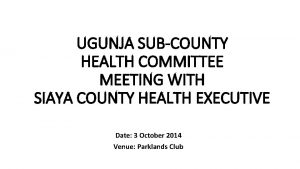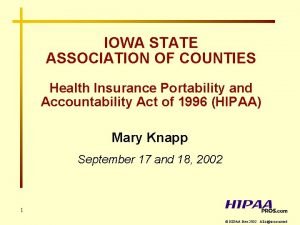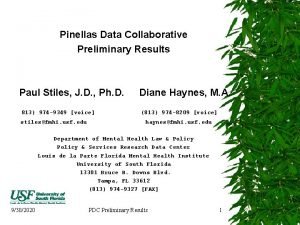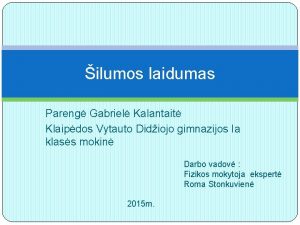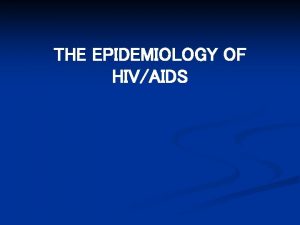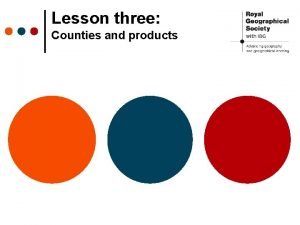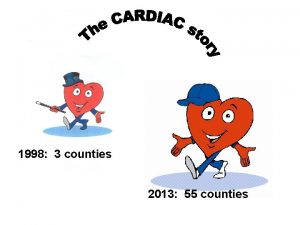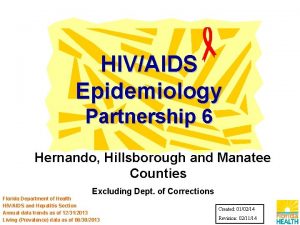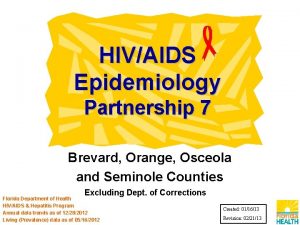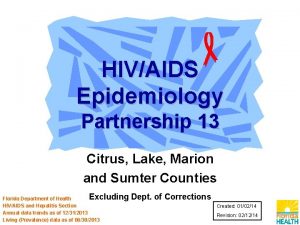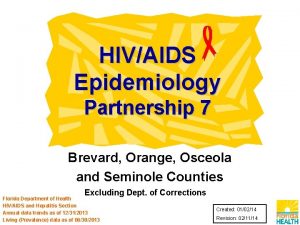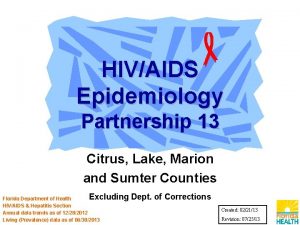HIVAIDS Epidemiology Partnership 5 Pasco and Pinellas Counties







































- Slides: 39

HIV/AIDS Epidemiology Partnership 5 Pasco and Pinellas Counties Excluding Dept. of Corrections Florida Department of Health HIV/AIDS & Hepatitis Program Annual data trends as of 12/28/2012 Living (Prevalence) data as of 05/16/2012 Created: 01/16/13 Revision: 02/21/13

HIV and AIDS Case Data AIDS Cases became reportable in Florida in 1981. HIV (not AIDS) became reportable in Florida on July 1, 1997. HIV Infection reporting represents newly Adult HIV Infection Cases, regardless of AIDS status at time of report, that were previously reported. AIDS cases and HIV infection cases by year of report are NOT mutually exclusive and CANNOT be added together. Frozen databases of year-end data are generated at the end of each calendar year. These are the same data used for Florida. CHARTS and all grant-related data where annual data are included. HIV prevalence data are generated later in the year, usually in May, when most of the “expected” death data are complete.

HIV and AIDS Case Data (con’t) Adult cases represent ages 13 and older, pediatric cases are those under the age of 13. For data by year, the age is by age of diagnosis. For living data, the age is by current age at the end of the most recent calendar year, regardless of age at diagnosis. Unless otherwise noted, whites are non-Hispanic and blacks are non-Hispanic. Unless otherwise noted. Area and county data will exclude DOC cases.

Cumulative HIV (not AIDS) and AIDS Cases, Reported through 2012, Partnership 5

AIDS Cases & Rates* By Year of Report, 2003 -2012, Partnership 5 Electronic laboratory reporting delays in late 2007 along with the expansion of electronic lab reporting, contributed to the artificial spike in 2008, followed by an annual approach to leveling. *Source: Population estimates are provided by Florida. CHARTS

HIV Infection Cases and Rates*, by Year of Report, 2003 -2012, Partnership 5 Note: Enhanced reporting laws in 2006 and the expansion of electronic lab reporting in 2007 led to an artificial peak in newly reported HIV infection cases in 2008. This was followed by an artificial decrease in 2009. Since then an upward trend in newly reported HIV infection cases was observed. *Source: Population estimates are provided by Florida. CHARTS

Adult AIDS Cases, by Sex and Year of Report, 2003 -2012, Partnership 5 M: F Ratio* Males 2003 4. 1: 1 2012 3. 9: 1 Females Note: AIDS cases tend to represent HIV transmission that occurred many years ago. The relative increases in males cases reflect the changing face of the AIDS epidemic over time. *The male-to-female ratio is the number of cases among males divided by the number of cases among females.

Adult HIV Infection Cases, by Sex and Year of Report, 2003 -2012, Partnership 5 M: F Ratio* Males 2003 2. 6: 1 2012 3. 6: 1 Females Note: Recent trends in HIV transmission are best described by the HIV case data. The relative increases in male HIV Infection Cases might be attributed to proportional increases in HIV transmission among men who have sex with men (MSM), which may influence future AIDS trends. *The male-tofemale ratio is the number of cases among males divided by the number of cases among females.

Adult AIDS and HIV Infection Cases by Sex, Reported in 2012, Partnership 5 AIDS N=171 Note: Partnership 5’s Adult Population is: 48% Male and 52% Female. HIV Infection N=261

Adult AIDS Cases by Race/Ethnicity and Year of Report, 2003 -2012, Partnership 5 Factors Affecting Disparities -Late diagnosis of HIV. White -Access to/acceptance of care. -Delayed prevention messages. Black -Stigma. Hispanic -Non-HIV STD’s in the community. -Prevalence of injection drug use. -Complex matrix of factors related to socioeconomic status Note: In 2012, blacks accounted for 31% of Adult AIDS cases, but only 7% of the population. From 2003 to 2012, the percent of AIDS cases among blacks and whites decreased by 9% and 7%, respectively. In contrast, among Hispanics the percent of AIDS cases increased 120% during the same time period. Numerous disparities can affect the increases of HIV disease in a given population. Other races represent less than 2% of the cases and are not included.

Adult HIV Infection Cases by Race/Ethnicity and Year of Report, 2003 -2012, Partnership 5 White Black Hispanic Note: HIV case reporting, implemented in mid-1997, reflects more recent trends in the epidemic with respect to the distribution of cases by race/ethnicity. From 2003 to 2012, whites represented the majority (45% or more) of the HIV infection Cases reported for most years. Over the past ten years, the percent of HIV Infection Cases among Hispanics increased by 22% and decreased by 8% among blacks. The percent among white HIV Infection Cases remained the same, from 2003 to 2012. Other races represent less than 3% of the cases and are not included.

Adult Male HIV Infection Cases by Race/Ethnicity and Year of Report, 2003 -2012, Partnership 5 White Hispanic Black Note: From 2003 to 2012, the percent of male HIV Infection Cases increased by 38% among Hispanic males and by 15% among black males. In contrast, the percent of male HIV Infection Cases decreased among white males by 11%. Whites represented the majority (>49%) of male HIV Infection Cases for most of the years.

Adult Female HIV Infection Cases by Race/Ethnicity and Year of Report, 2003 -2012, Partnership 5 Black White Hispanic Note: From 2003 to 2012, the percentage of female HIV Infection Cases increased by 57% among white females. In contrast, the percentage of female HIV Infection Cases decreased among black and Hispanic females by 8% and 25% respectively, over the past ten years.

Adult AIDS Case Rates* by Sex and Race/Ethnicity, Reported in 2012, Partnership 5 Rate Ratios: MALES Black: White, 4. 9: 1 Hispanic: White, 1. 9: 1 FEMALES Black: White, 11. 8: 1 Hispanic: White, 1. 9: 1 Note: Among black males, the AIDS case rate is nearly 5 times higher than the rate among white males. Among black females, the AIDS case rate is nearly 12 times higher than the rate among white females. Hispanic male and female rates are higher than the rates among their white counterparts. *2012 Partnership 5 Population *Source: Population estimates are provided by Florida. CHARTS

Adult HIV Infection Case Rates* by Sex and Race/Ethnicity, Reported in 2012, Partnership 5 Rate Ratios: MALES Black: White, 6. 2: 1 Hispanic: White, 1. 9: 1 FEMALES Black: White, 9. 3: 1 Hispanic: White, 2. 1: 1 Note: Among black males, the HIV Infection case rate is 6 times higher than the rate among white males. Among black females, the HIV case rate is 9 times higher than the rate among white females. Among Hispanic male and females, the HIV case rates are higher than the rates among their white counterparts. . *Source: Population estimates are provided by Florida. CHARTS

Adult AIDS and HIV Cases Reported in 2012 and Population Data, by Race/Ethnicity, Partnership 5 2012 Partnership 5 Population Estimates* N=1, 210, 931 AIDS N=171 White Black Hispanic HIV Infection N=261 Other** Note: In this snapshot for 2012, blacks are over-represented among the AIDS and HIV Infection Cases, accounting for 31% of adult AIDS cases and 33% of adult HIV Infection Cases, but only 7% of the adult population. A group is disproportionately impacted to the extent that the percentage of cases exceeds the percentage of population. *Source: Population estimates are provided by Florida. CHARTS **Other includes Asian/Pacific Islanders, Native Alaskans/American Indians and mixed races.

Adult HIV Infection Cases, by Age Group at Diagnosis, and Year of Report, 2003– 2012, Partnership 5 Note: From 2003 to 2012, the proportion of adult HIV Infection Cases among those aged 50+ and 20 -29, increased by 108% and 4%, respectively.

Adult HIV Infection Cases, by Sex and Age Group at Diagnosis, Reported in 2012, Partnership 5 Males N=247 Females N=59 Note: HIV Infection Cases tend to reflect more recent transmission than AIDS cases, and thus present a more current picture of the epidemic. With regard to the age group with the highest percent of HIV Infection Cases, recent estimates show that among males, 28% of HIV Infection Cases occur among those aged 20 -29, whereas among females, 26% of HIV Infection Cases occur among those aged 30 -39 and 50+ (respectively for both).

Definitions of Mode of Exposure Categories MSM = Men who have sex with men IDU = Injection Drug Use MSM/IDU = Men who have sex with men & Injection Drug Use Heterosexual = Heterosexual contact with person with HIV/AIDS or known HIV risk OTHER = includes hemophilia, transfusion, perinatal and other pediatric risks and other confirmed risks. NIR = Cases reported with No Identified Risk Redistribution of NIRs = This illustrates the effect of statistically assigning (redistributing) the NIRs to recognized exposure (risk) categories by applying the proportions of historically reclassified NIRs to the unresolved NIRs.

Adult Male HIV Infection Cases, by Mode of Exposure and Year of Report, 2003– 2012, Partnership 5 Note: NIRs redistributed. Men who have sex with men (MSM) remains as the primary mode of exposure among male HIV cases in Partnership 5, followed by heterosexual contact.

Adult Female HIV Infection Cases by Exposure Category and Year of Report, 2003 -2012, Partnership 5 Note: NIRs redistributed. The heterosexual risk continues to be the dominant mode of exposure among females.

Adult Male AIDS and HIV Infection Cases, by Mode of Exposure, Reported in 2012, Partnership 5 AIDS N=136 HIV Infection N=204 Note: NIRs redistributed. Among the male AIDS and HIV Infection Cases reported for 2012, men who have sex with men (MSM) was the most common risk factor (69% and 77% respectively) followed by cases with a heterosexual risk (12% for AIDS and 9% for HIV). The recent increase among MSM is indicated by the higher MSM among HIV Infection Cases compared to AIDS cases, as HIV Infection Cases tend to represent a more recent picture of the epidemic.

Adult Female AIDS and HIV Infection Cases, by Mode of Exposure, Reported in 2012, Partnership 5 AIDS N=35 HIV Infection N=57 Note: NIRs redistributed. Among the female AIDS and HIV Infection Cases reported for 2012, heterosexual contact was the highest risk (74% and 86% respectively).

Cases Living with HIV Disease

Adults Living with HIV Disease By Zip Code, Reported through 2011, Partnership 5 Total Living HIV/AIDS Cases 0 1 - 25 26 - 50 51 - 75 Over 75 N=4, 146 Excludes DOC, homeless, and cases with unknown zips. Data as of 05/16/2012

Men who have Sex with Men (MSM)* Living with HIV Disease By Zip Code, Reported through 2011, Partnership 5 Presumed Living MSM HIV/AIDS Cases 0 1 - 25 26 - 50 51 - 75 Over 75 N=2, 428 NIRs are not redistributed. Excludes DOC, homeless, and cases with unknown zips. *Includes MSM/IDU cases. Data as of 05/16/2012

Men who have Sex with Men (MSM)* Living with HIV Disease By Zip Code, Reported through 2011, Tampa/St. Pete EMA Presumed Living MSM HIV/AIDS Cases 0 1 - 25 26 - 50 51 - 100 Over 100 N=10, 147 NIRs are not redistributed. *Includes MSM/IDU. Data as of 05/16/2012

Injection Drug Users (IDUs)* Living with HIV Disease By Zip Code, Reported through 2011, Partnership 5 Presumed Living IDU HIV/AIDS Cases 0 1 - 10 11 - 20 21 - 30 Over 30 N=649 NIRs are not redistributed. Excludes DOC, homeless, and cases with unknown zips. *Includes MSM/IDU cases. Data as of 05/16/2012

Adult Heterosexuals Living with HIV Disease By Zip Code, Reported through 2011, Partnership 5 Presumed Living Heterosexual HIV/AIDS Cases 0 1 - 10 11 - 20 21 - 30 Over 30 N=933 NIRs are not redistributed. Excludes DOC, homeless, and cases with unknown zips. Data as of 05/16/2012

Adults Living with HIV Disease By Zip Code and Race/Ethnicity, Reported through 2011, Partnership 5 1 Dot = 3 cases Dots are randomly placed within zip codes. Hispanic Black, not-Hispanic White, not-Hispanic N=4, 146 Total includes all races, some which are not on map. Excludes DOC, homeless, and cases with unknown zips. Data as of 05/16/2012

Adults Living with HIV Disease By Zip Code and Sex, Reported through 2011, Partnership 5 1 Dot = 3 cases Dots are randomly placed within zip codes. Male Female N=4, 146 Excludes DOC, homeless, and cases with unknown zips. Data as of 05/16/2012

Case Rates* of Adults Living with HIV Disease, by Sex and Race/Ethnicity, Reported through 2011, Partnership 5 RATE RATIOS: MALES Blacks: Whites, 3. 7: 1 Hispanics: Whites, 1. 0: 1 FEMALES Black: Whites, 12. 4: 1 Hispanics: Whites, 2. 5: 1 Note: Among black males, the HIV/AIDS case rate for cases alive and reported through 2011 is 3 times higher than among white males. Among black females, the HIV/AIDS case rate is 12 times higher than among white females. Hispanic male rates are 1 time higher and Hispanic female rates are 2 times higher than the rates among their white counterparts. Data excludes Department of Corrections cases. *Source: Population estimates are provided by Florida. CHARTS **Other includes Asian/Pacific Islanders and Native Alaskans/American Indians.

Adult Males Living with HIV Disease by Race/Ethnicity and Mode of Exposure Reported through 2011, Partnership 5 White Non-Hispanic, N=2, 152 Black Non-Hispanic, N=721 Hispanic, N=241 Note: NIRs redistributed. Among males living with HIV disease, the distribution of risk among blacks differs from that among whites and Hispanics. MSM represents the highest risk for all races. White males have the smallest proportion of heterosexual contact cases.

Adult Females Living with HIV Disease by Race/Ethnicity and Mode of Exposure Reported through 2011, Partnership 5 White Non-Hispanic, N=401 Black Non-Hispanic, N=469 Hispanic, N=102 Note: NIRs redistributed. Among females living with HIV disease, the distribution of risk among whites differs from that among blacks and Hispanics. Heterosexual contact is the majority risk for all races, However, whites have the highest proportion of IDU cases.

Annual Prevalence of Adults Living with HIV Disease, 1995 -2011, Partnership 5 As a result of declining deaths, annual HIV/AIDS diagnoses have exceeded deaths since 1995, and the number of persons reported with HIV/AIDS that are presumed to be alive has been increasing. Since the year 1995, prevalent cases have increased by over 420%. In 2011 the prevalence increased by 6%.

Resident Deaths due to HIV Disease by Year of Death, 1995 -2011, Partnership 5 Source: Florida Department of Health, Office of Vital Statistics, Death Certificates (as of 07/12/12). Population data are provided by Florida. CHARTS.

Some Useful Links CDC HIV/AIDS Surveillance Reports (State and Metro Data): http: //www. cdc. gov/hiv/stats/hasrlink. htm MMWR (Special Articles on Diseases, Including HIV/AIDS): http: //www. cdc. gov/mmwr/ U. S. Census Data (Available by State, County): http: //www. census. gov Partnership 5 Dept. of Health, HIV/AIDS & Hepatitis Program Website (Slide Sets, Fact Sheets, Monthly Surveillance Report, Counseling & Testing Data, etc. ): http: //www. doh. state. fl. us/disease_ctrl/aids/index. html

“The reason for collecting, analyzing and disseminating information on a disease is to control that disease. Collection and analysis should not be allowed to consume resources if action does not follow. ” --Foege WH et al. Int. J of Epidemiology 1976; 5: 29 -37

For Florida HIV/AIDS Surveillance Data Contact: (850) 245 -4444 Lorene Maddox, MPH Tracina Bush, BSW Madgene Moise, MPH Ext. 2613 Ext. 2612 Ext. 2373 Visit Florida’s internet site for: • Monthly Surveillance Reports • Slide Sets and Fact Sheets • Annual Reports and Epi Profiles http: //www. doh. state. fl. us/disease_ctrl/aids/trends. html Visit CDC’s HIV/AIDS Internet site for: Surveillance Reports, fact sheets and slide sets http: //www. cdc. gov/hiv/topics/surveillance/resources/reports/index. htm Special acknowledgement given to Heidi Dutton for her contribution to the slide sets.
 Joint meeting of essex and union counties
Joint meeting of essex and union counties River shannon facts
River shannon facts Republic of ireland counties
Republic of ireland counties Siaya sub counties
Siaya sub counties Iowa state association of counties
Iowa state association of counties Thesourceagents
Thesourceagents Advantages and disadvantages of nutritional epidemiology
Advantages and disadvantages of nutritional epidemiology Difference between descriptive and analytical epidemiology
Difference between descriptive and analytical epidemiology Incidence vs prevalence
Incidence vs prevalence Certification board of infection control and epidemiology
Certification board of infection control and epidemiology Descriptive epidemiology
Descriptive epidemiology Title 1 schools pinellas county
Title 1 schools pinellas county Pinellas county report cards
Pinellas county report cards Gates.powerschool
Gates.powerschool What time does pinellas park middle school start
What time does pinellas park middle school start Pinellas county school transportation
Pinellas county school transportation Pinellas advanced scholar
Pinellas advanced scholar Belcher elementary
Belcher elementary Facade design hillsborough, pinellas,
Facade design hillsborough, pinellas, Pinellas cjis
Pinellas cjis Pinellas parent portal
Pinellas parent portal Usep
Usep Sparkvue app
Sparkvue app Pasco airlink
Pasco airlink Pasco county cpi
Pasco county cpi Pineview middle school
Pineview middle school Pasco capstone
Pasco capstone Pasco glx
Pasco glx Canvas pasco
Canvas pasco Dr timi maloney
Dr timi maloney Northwest farm credit services pasco wa
Northwest farm credit services pasco wa Pasco sanitary landfill
Pasco sanitary landfill Kurt s. browning
Kurt s. browning Perbedaan relative risk dan odds ratio
Perbedaan relative risk dan odds ratio Logistic regression epidemiology
Logistic regression epidemiology Prevalence rate formula
Prevalence rate formula Classification of epidemiological studies
Classification of epidemiological studies Attack rate calculation
Attack rate calculation Bibliography of epidemiology
Bibliography of epidemiology Temporal relationship epidemiology example
Temporal relationship epidemiology example



